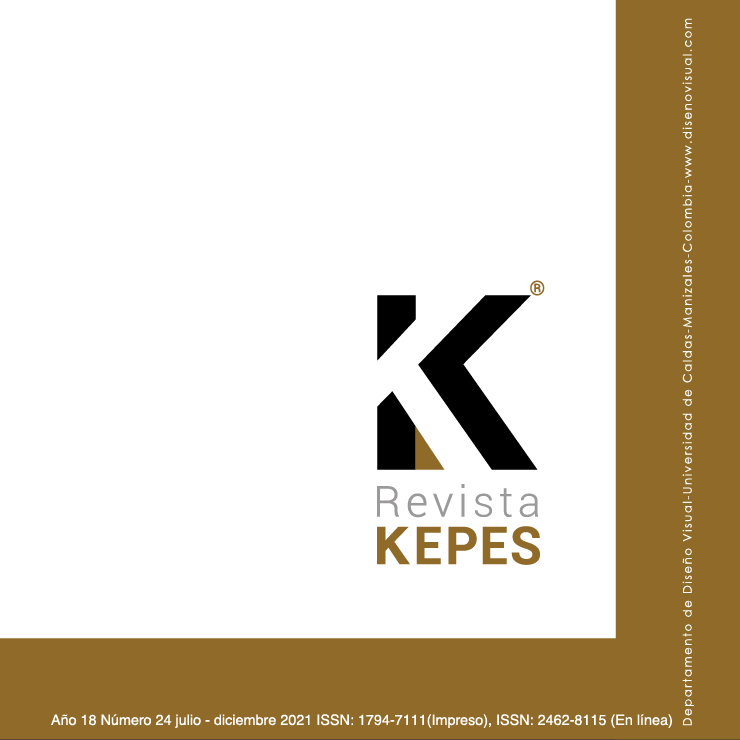Authors
Abstract
This is a qualitative research of an exploratory nature, which seeks to examine the conceptual correspondence between the rhetorical qualities of typographic expressions present in the advertising signs of a particular urban area and the essential cultural components of that environment, captured through visual ethnography. The case study was carried out in the Meiggs neighborhood, located in the city of Santiago de Chile.
Through visual ethnography the sociocultural events of the neighborhood were captured through photographs. This led to a cataloging of the captures based on identification and description parameters which allowed grouping them based on descriptive matches. Ten groups were formed and a photo of each one was selected for the study. A connotative interpretation template was created for the analysis of the images which enabled to reach a conceptual synthesis based on referential and non-referential thematic descriptors. Each photograph was accompanied by a news story concerning the neighborhood and related to its specific content. Subsequently, the news stories were synthesized into concepts using a speech analysis software (part-of-speech.info) and, from there, it was possible to establish an essential concept of photography and its content. Then the typographic expression present in the labels was also subjected to the process of connotative interpretation and rhetorical analysis, managing to find in all the cases analyzed, a conceptual correspondence between the ethnographic images and the typographical expressions.
Understanding that it is from, and in the public space where the urban landscape is articulated, and that the behaviors, actions, interactions, mobility and material and intangible symbolic manifestations of the people who inhabit that space are evidenced there, the typographic expressions in this case, those present in the advertising labels of the environment, emerge in that context as material representations of this sociocultural event, in this case from the Meiggs neighborhood.
Keywords
References
Amare, N. y Manning, A. (2012). Seeing typeface personality: Emotional responses to form as tone. IEEE International Professional Communication Conference. https://doi.org/10.1109/IPCC.2012.6408605
Aristía, T. (2017). La ruta de la moda falsificada en Chile. Facultad de Ciencias Sociales. http://socialesehistoria.udp.cl/la-ruta-de-la-moda-falsificada-en-chile/
Arnheim, R. (1986). El pensamiento visual. Paidós.
Bonsiepe, G. (1999). Del objeto a la interfase. Mutaciones del Diseño. Ediciones Infinito.
Brandis, D. y Del Río, M. I. (2016). Paisaje y espacio público urbano. El deterioro de las plazas del centro histórico madrileño (1945-2015). Cuadernos Geográficos de La Universidad de Granada, 55(2), 238-264. https://dialnet.unirioja.es/servlet/articulo?codigo=5767233
Bringhurst, R. (2008). Los elementos del estilo tipográfico. FCE.
Brisset, D. E. (2004). Visual anthropology and photographic analysis. Gazeta de Antropología, 20. http://hdl.handle.net/10481/7252
Brumberger, E. (2003a). The rhetoric of typography: the awareness and impact of typeface appropriateness. Technical Communication. https://doi.org/http://dx.doi.org/10.1108/17506200710779521
Brumberger, E. (2003b). The rhetoric of typography: The Persona of Typeface and Text. Technical Communication, 50(2), 206-223. https://doi.org/http://dx.doi.org/10.1108/17506200710779521
Brumberger, E. (2004). The rhetoric of typography: Effects on Reading Time, Reading Comprehension, and Perceptions of Ethos. Technical Communication.
Codoceo, F. (2012). Guía Urbana de Santiago: Estación Central y Barrio Meiggs, Plataforma Urbana. Plataforma Urbana. http://www.plataformaurbana.cl/archive/2012/10/30/guiaurbana-de-santiago-estacion-central-y-barrio-meiggs/
Delgado, M. (2007). Sociedades movedizas. Pasos hacia una antropología de las calles. Anagrama.
Emol. (2018). Barrio Chino: Locatarios y vecinos de Meiggs destacan idea aunque piden priorizar la seguridad. http://www.emol.com/noticias/Nacional/2018/05/27/907622/Barrio-ChinoLocatarios-y-vecinos-de-Meiggs-destacan-idea-aunque-piden-priorizar-la-seguridad.html
Gamonal, R. (2005). Tipo/Retórica: Una aproximación a la Retórica Tipográfica. Ícono 14 Revista de Comunicación y Nuevas Tecnologías, 05. www.redalyc.org/revista.oa?id=5525
Gómez, Y. N. I. (2010). La Cultura del Diseño, estrategia para la generación de valor e innovación en la PyMe del Área Metropolitana del Centro Occidente, Colombia. Cuadernos Del Centro de Estudios En Diseño y Comunicación, 34(Ensayos), 109-209.
Juni, S. y Gross, J. S. (2008). Emotional and Persuasive Perception of Fonts. Perceptual and Motor Skills, 106(1), 35-42. https://doi.org/10.2466/pms.106.1.35-42 La Nación. (2011). Comerciantes de barrio Meiggs aumentan ventas por Halloween. La Nación. http://lanacion.cl/2011/10/31/comerciantes-de-barrio-meiggs-aumentan-ventas-porhalloween/
Martínez-Val, J. (2002). Tipografía Práctica. Ediciones Laberinto.
Morrison, G. R. (1986). Communicability of the emotional connotation of type. ECTJ, 34(4), 235- 244. https://doi.org/10.1007/bf02767404
Municipalidad de Santiago. (2016). Diagnóstico comunal de seguridad pública. https://issuu.com/munistgo/docs/cap_3_barrio_meiggs_2016-frc
Nedeljković, U., Novaković, D. y Pinćjer, I. (2017). Detecting universal structure and effects of typefaces. Tehnicki Vjesnik - Technical Gazette, 24(2). https://doi.org/10.17559/TV20150831131738
Ørmen, J. (2016). Googling the news: Opportunities and challenges in studying news events through Google search. Digital Journalism, 4(1), 107-124. https://doi.org/10.1080/21670811.2015.1093272
Ruiz, J. I. (2012). Metodología de la investigación cualitativa. Universidad de Deusto.
Sánchez, R. C. y Baños, O. (2019). El paisaje urbano de las ciudades pequeñas. La plaza central de Hunucmá Yucatán. Relaciones Estudios de Historia y Sociedad, 40(158), 145-175.https://doi.org/10.24901/rehs.v40i158.367
SERCOTEC. (2016a). Barrios Comerciales.
SEGEGOB. (2016b). Organizaciones Comunitarias Vigentes.
Shaikh, A. D., Chaparro, B. S. y Fox, D. (2006). Perception of Fonts: Perceived Personality Traits and Uses, 8(1). http://www.shaikh.us/fontstudy/Sparke, P. (2010). Diseño y cultura, una introducción: desde 1900 hasta la actualidad. Gustavo Gili.
Stöckl, H. (2005). Typography: Body and dress of a text - a signing mode between language and image. Visual Communication, 4(2), 204-214. https://doi.org/10.1177/1470357205053403
Stötzner, A. (2003). Signography as a Subject in its Own Right. Visual Communication, 2(3), 285- 302. https://doi.org/10.1177/14703572030023003
Subsecretaría de Prevención del Delito. (2015). Estudio del Comercio Ambulante no autorizado en Santiago y sus Implicancias en la Seguridad Ciudadana.
Toutanova, K., Klein, D., Manning, C. y Singe, Y. (2003). Feature-Rich Part-of-Speech Tagging with a Cyclic Dependency Network. HLT-NAACL 2003, 252-259.
Tselentis, J. y Saltz, I. (2012). Contemporary usage: designing with type. In Tyoography Referenced (pp. 234-319). Rockport.
Walker, S. (2014). Typography & Language in Everyday Life. Routledge. https://doi.org/10.4324/9781315839332

 pdf (Español (España))
pdf (Español (España))
 FLIP
FLIP






















